What is Database Management System (DBMS)?
Database performance management system is designed to help admins more easily troubleshoot and resolve DBMS performance issues by monitoring performance and providing root-cause analysis of your database using multi-dimensional views to answer the who, what, when, where, and why of performance issues. These database monitoring tools can also help you use best practice methods to tune your databases and SQL queries to improve database performance.
What is Database Management System (DBMS)?
Database Management System (DBMS) Definition
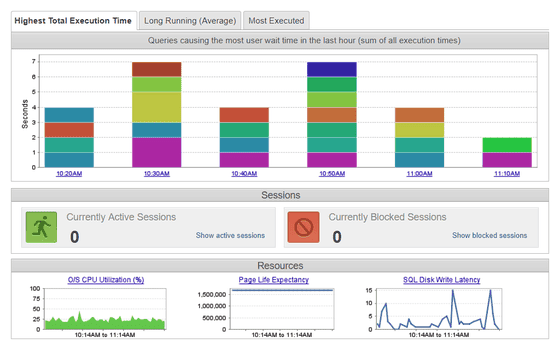
To fully understand DBMS, it’s important to understand the definition of a database management system. For data-driven companies, a DBMS is the preferred solution for mission-critical applications.
There are several types of DBMS software, each with their own way of structuring and using data:
- Relational databases refer to data organized in tables in which there are relationships between tables. Querying occurs in Structured Query Language, or SQL. Examples of RDBMSs include Oracle, MySQL, Microsoft SQL Server, and PostgreSQL.
- NoSQL databases are schema-free. This form of database allows more data variety than RDBMSs. Examples include Cassandra, MongoDB, and Oracle NoSQL.
- Columnar databases are a useful form for data warehouses with vast amounts of similar data. This data can be highly compressed.
- Cloud-based databases refers to either PaaS/DBaaS solutions such as Azure SQL Database, Amazon RDS, and Aurora. Cloud hosted or IaaS examples include SQL Server in Azure VM and Amazon EC2.
Popular DBMS types include:
- MySQL
- Oracle
- Microsoft SQL Server
- SAP ASE
- IBM DB2 LUW
- Aurora
- MariaDB
- PostgreSQL
There are also three types of database architecture:
- One-tier architecture is where the client and server reside on the same machine as the database. This occurs when you install a database directly onto your system, typically for SQL query practice.
- Two-tier architecture is where data is stored on a server and clients (like PCs) run the presentation layer. The DBMS is not directly exposed to the end user but can be called by an API.
- Three-tier architecture is where the application layer exists between the database and the client, so a server controls the user requests and DBMS responses based on functional logic and rules. This is the most common architecture for web applications.
The type of DBMS and architecture of your database environment is important because they can affect your ability to scale up effectively, remove redundancies, allow multi-user access, and how you handle complicated transactions. Not every organization recognizes its DBMS—whether MySQL, Oracle, or another program—may require performance management. In fact, poor database performance and slow response times can lead to high costs for an organization. Manual troubleshooting can require hours or days of admin time to resolve an issue, while customers and employees may be affected by the failure in business function.
Database performance management software is designed to help admins more easily troubleshoot and resolve DBMS performance issues by monitoring performance and providing root-cause analysis of your database using multi-dimensional views to answer the who, what, when, where, and why of performance issues. These database monitoring tools can also help you use best practice methods to tune your databases and SQL queries to improve database performance.
Why is database monitoring important?
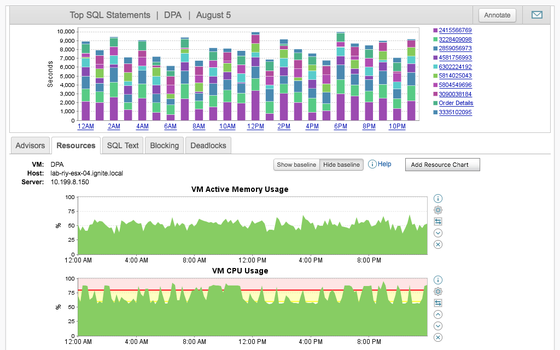
A DBMS can be used to manage employee records, track inventory, or handle other business tasks and allow for fast data access (typically through SQL queries), strong data relationships, efficient data updating, and easy data searching. When your DBMS runs efficiently, this data is readily available for users and applications. Database monitoring tools and performance management software can help ensure business productivity by improving the performance of your DBMS. The value added by using automated, API-driven tools can be significant to companies preoccupied with the cost of constant database performance management and optimization for large data systems.
With DBMS performance management software, databases can also be consolidated into a single, centrally controlled management hub where admins can enjoy a range of useful features for multi-database control. The following are some common database issues and how database performance software can help mitigate them:
- Scalability. As data volumes rise, there’s no guarantee your current database design will be able to cope. You need the right tools to help support high transactional throughput and flag the places where your configuration is causing high latency.
- Query slowness. Is it the database resources, a poorly written query, or index issues? It can be difficult to collect all the necessary information to quickly answer these questions. Database monitoring software can display pertinent information, including customizable performance metrics, in just one click.
- Missing or duplicate indexes. An indexing strategy can be one of the toughest problems a DBA may face. The tendency is to index an object instead of indexing for how it’s going to be queried. This database issue often leads to too many indexes on the underlying objects, which can cause performance regression. A database performance management solution can help you identify missing and duplicate indexes faster, so you can improve database performance.
- Workload optimization. Database monitoring tool insights can help you understand an inefficient workload based on production usage patterns. View the hot objects, impactful queries, and plans involved so you can make the best performance tuning decisions to eliminate inefficiencies.
Database performance management software is powerful in large part because it provides task automation and alerting capabilities capable of transforming your DBMS visibility and workflow. Database performance management software automatically monitors the full database structure, from SQL queries to resource consumption and contention. - Automation. Companies with large mission-critical applications and multiple databases can automate some of their management and issue mitigation, reducing the workload for IT admins and leaving more time for innovation instead of data babysitting. To intelligently monitor database processes, database performance management software uses machine learning to detect anomalies versus traditional threshold-based monitoring. Monitoring tools in database performance management software can also examine SQL queries and plans.
- Alerting. Automatic detection and notification capabilities are also appealing for DBAs, DevOps, and AppDevs who need more visibility into their DBMS instances. Alerts automatically flag issues and offer drill-down information about the problems, so you don’t have to go looking for the bottleneck. You can do more with your time as an administrator.
What are the advantages of a DBMS?
Allow Administration of Data A DBMS facilitates interactions between users and data. It helps database and system administrators monitor and assess the performance of the database, restrict user access to the database, maintain and verify data, and recover information that may have become corrupted. Database administrators can also update, modify, retrieve, and delete data using a DBMS.
Reduce Data Redundancy Data redundancy is the repetition or duplication of data within a database. A DBMS reduces data redundancy by maintaining a single repository that can be defined, modified, and updated. Minimizing data redundancy improves database consistency, enhances storage, and promotes data integrity.
Promote Data Integrity Data integrity refers to the overall accuracy, consistency, and completeness of data stored in a database. A DBMS runs tests to check errors and validate data. This helps increase the stability and performance of the database. Maintaining data integrity helps ensure recoverability, searchability, and connectivity within a database.
Allow Sharing of Data Data sharing is a primary feature of a database management system (DBMS). However, to share data within or outside an organization, users must follow the correct authorization protocol. Different levels of authorizations need to be taken care of to make the data accessible.
Provide Data Security Data loss can lead to financial loss, reputation damage, brand erosion, and non-compliance of government and industry regulations. Database security is crucial as it prevents data from getting corrupted or lost due to programming errors. An efficient DBMS reinforces policies to allow secure management of databases, keep sensitive information safe, and enable compliance and security.
How to manage database performance?
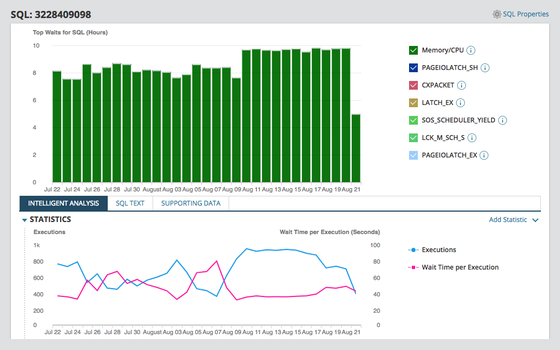
Managing database performance involves many factors, from indexes and queries to servers and storage. You must be sure you’re monitoring the right metrics, following best practices, and optimizing key functions across your DBMS infrastructure, which can be a challenge. Many organizations turn to software to fulfill the numerous tasks required for effectively managing database performance, such as:
- Optimizing and tuning database indexes. Indexing is the data structuring technique that enables quick record retrieval. Indexes search keys and return matching records—a seemingly simple process. However, a lack of index tuning can cause performance problems. Improve your indexing strategy by experimenting with the following tips for reducing query processing time:
- Index based on workload—how the data will be accessed. This helps optimize SQL querying.
- Queries occurring every day are high priority, and you should build indexes to streamline these queries.
- Do queries return exceedingly large amounts of data? Consider creating filtered columns.
- Periodically check for missing or duplicate indexes. Too many unused indexes can impede your backups.
- Be careful with cache sizes in case your hit rate drops too low—start with 10MB, and don’t exceed roughly 150MB.
- Avoid correlated subqueries and coding loops, which can drag down performance.
- Understanding who’s using your databases. Do you know what applications and services are accessing your database? If you’re not tracking access permissions, a single client could be slowing down your overall performance. Similarly, connection acquisition could easily be dragging down response time. Performance may also be flagged if your database is trying to handle too much, especially if it's set to allow the maximum potential number of connections. Set the pool at one constant size to achieve the best results while ensuring this set capacity doesn’t exceed CPU or memory.
- Tracking key metrics for database performance tuning. It’s important to monitor database metrics providing useful insights into performance. Your database performance management software should collect metrics at regular intervals, whether once per second or once every few minutes. Performance metric categories include both top-level work metrics (like throughput, result errors, component performance, and success rates) and resource metrics for monitoring hardware, software, and network components (like utilization, saturation, internal errors, and database availability).
These top measurements can provide critical visibility into how your database is functioning:- Disk I/O helps you understand read/write transactions. Problems with this metric can signal bottlenecks.
- Memory is important because a lack of sufficient memory causes issues. You can track other metrics like page faults to more comprehensively understand memory.
- User connections are important to track because too many connections quickly drag down overall performance.
- CPU workload can help reveal if there are too many user connections, if a system is being overburdened, and if you need to invest in new hardware.
- Transaction log configuration can allow you to leverage transaction log files for recovery in case of system failure. You should maintain a backup copy, track log size, and otherwise ensure the log isn’t corrupted.
- Query optimization. Queries, which are requests for data from the DBMS, need to be optimized to ensure the information is returned accurately and quickly. Queries can gather the data they need in different ways, but not every way offers equally fast processing. To effectively optimize your queries, the first step is to monitor query metrics. A database performance management software program can provide instant visibility into which SQL queries are slow and why. You can then identify what key SQL queries you’d like to fix based on slowest response time and/or highest end-user impact.
- DBMS transaction management. You should also be considering the role your servers play in DBMS transaction management. In general, application performance metrics and user experience metrics provide front-end insight into whether your DBMS server is functioning efficiently. By tracking these metrics, you can get a sense of whether your current performance is adequate for your customers and employees.
- App performance metrics reveal web app speed and include requests per second, data in/data out, peak response time, and average response time.
- User experience metrics are all about end-user satisfaction and include uptime and HTTP server error rate.
- Providing hardware insights. Another way to improve database performance is to spend money on hardware upgrades. However, you don’t want to do this without cause, so you should make sure you’re tracking hardware metrics like CPU, memory allocation, and disk latency to better understand how your hardware is currently being used.
What are database monitoring tools?
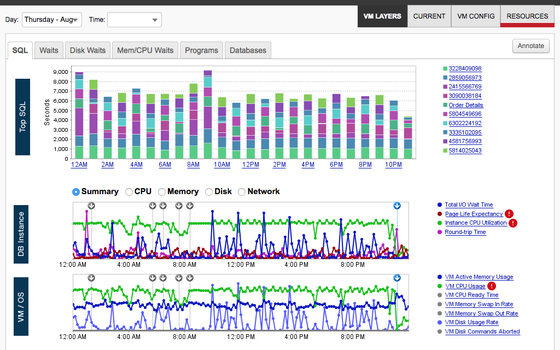
Database monitoring tools are solutions designed to monitor your database management system. Database monitoring software uses a multi-pronged approach for performance optimization designed to help free time and resources for database admins. Database monitoring can also provide solutions to improve many areas of a database structure, including:
Troubleshoot hotspots and bottlenecks. When a data hotspot is slowing down database performance, database monitoring tools can help you troubleshoot and offer useful recommendations.
Dealing with limited server resources. To deal with suboptimal server resources, database performance management software might identify when a query is limited by storage capacity and improve SQL communication with lower overhead.
Tuning suboptimal SQLs. Comprehensive DB performance management software can also help fix SQL limitations by identifying ineffective queries and tuning them for better performance.
If you’re wondering how to choose a database monitoring solution, you should ask yourself the following questions before making an investment:
- Does the tool provide query tuning advice? Can it catch database replication and identify blocked SQL queries?
- Does the platform offer multi-vendor compatibility for SQL Server, MySQL, MariaDB, Oracle, Amazon RDS, EC2, and more?
- Does the tool offer database anomaly detection powered by machine learning?
- Does it come with an intuitive dashboard displaying a wide range of top-level and drill-down metrics on queries, database performance, hardware health, and more?
- Does the tool help you with server performance tuning to ensure good end-user experience?
- Will it integrate with other your other monitoring and management solutions, so database performance management becomes part of your overall IT monitoring strategy?
Database monitoring software requirements
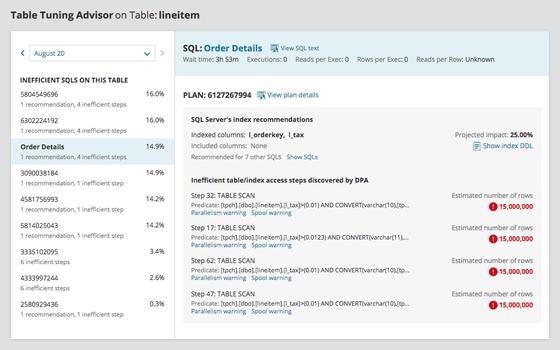
If you’re looking to invest in database monitoring tools, it’s critical you choose a solution with the right functionalities and features. The following are some top capabilities an enterprise-grade database performance management solution should support.
- Intuitive performance analysis. Choose easy drill in, context setting, and consistent navigation. Database performance management software can help you understand your performance picture at a glance and across key dimensions, including SQL, waits, applications, users, and more.
- Blocking analysis. See what’s being blocked and what’s doing the blocking. Get help understanding your blocking hierarchy as well as the overall impact to your performance caused by database blocking.
- Database, index, and query tuning advisors. You need the right data to optimize your database, indexes, and queries. Identify high-impact, inefficient T-SQL to find indexing opportunities. Perform an “X-marks-the-spot” analysis of actual workload for SQL Server and Oracle.
- Real-time and historic monitoring. Execute root cause analysis immediately, or time travel with historic data. You need a database performance management tool built to provide 24/7 monitoring, which can help answer why performance is or was bad and help you get a handle on where performance is headed and how your system is trending.
- Multi-vendor relational database support. Use one tool to monitor multiple popular database types. Look for support for monitoring SQL Server (including Azure SQL Databases), Oracle, MySQL, MariaDB, Aurora, IBM DB2, and SAP ASE (on-premises, virtualized, or in the cloud) all in one view.
- Integration with other products. Gain upstream and downstream visibility of application, server, storage, infrastructure health, and operational status with dependency mapping and customizable dashboards integrating your database performance management solutions with other system monitoring tools.
- Anomaly detection. See when behavior is different than expected using machine learning that gets better over time. Let machine learning do the hard work to understand your instance wait behavior profile. Tune your workflow to focus on problem spots when they occur in your environment.
- Management API. Automate or programmatically manage your monitored database environment for easier deployment and scalability. Use a management API to free up time from managing large or dynamic database environments to focus on more value-add activities like tuning and optimization.
What is SolarWinds Database Performance Analyzer (DPA)?
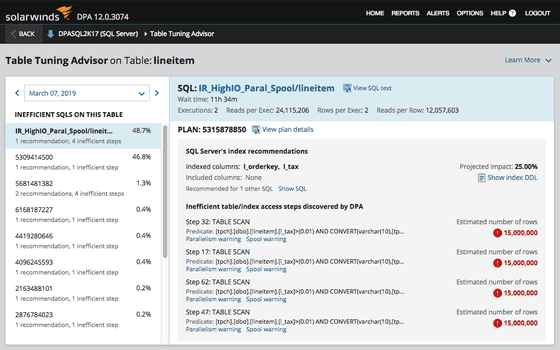
You may be wondering: why is my query slow? Are my indexes correct? Is my workload not optimized? Dozens of factors affect DBMS performance, but it isn’t always easy to figure out what metrics matter or where to start with performance tuning. To optimize their resources, admins need access to time-saving automation and alerting capabilities with visibility into critical metrics across multi-vendor platforms while supporting the next steps toward an optimized database.
SolarWinds® Database Performance Analyzer is built to deliver better results by taking a different approach to improve your database management system. DPA supports these must-have capabilities, so you can more easily tune performance and optimize the efficiency of your DBMS.
What makes DPA database monitoring tools different?
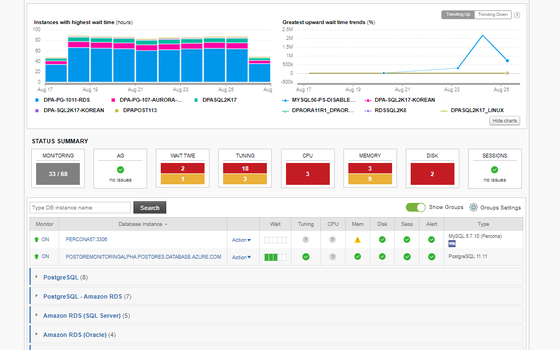
- Monitor across a variety of DBMS. Database Performance Analyzer monitors all these databases from a single installation: SQL Server, Oracle, MySQL, MariaDB, Aurora, DB2, and SAP ASE, spanning on-premises and cloud.
- Quickly find the root cause of your complex database problems. Anomaly detection powered by machine learning and response-time analysis show you exactly what needs fixing, whether you’re a database expert or not.
- Less than 1% load on monitored instances. Agentless architecture is designed to be safe for dev, test, and production—and scale to monitor thousands of database instances.
- Solve problems faster when teams collaborate. Application developers, DBAs, and DevOps teams work together to help eliminate finger-pointing by providing full visibility into an organization’s DBMS.
- Be proactive about performance management. Identify anomalies before problems occur. Machine learning creates intelligent baselines to detect standard deviations greater than two to identify issues. Get alerts and custom reports, too.
- Monitor all your databases in hybrid environments—on-premises, virtualized, and in the cloud. Don't be forced into multiple database performance management tools for monitoring. Get DPA instead. DPA's database monitoring tools are designed to provide full coverage of your databases, no matter how it's deployed. Physical, virtual, cloud (IaaS, PaaS, or DBaaS), our database performance management solution can keep you covered in a single pane of glass.
If you’re looking for a comprehensive DBMS performance management solution, download a free trial to see if SolarWinds Database Performance Analyzer has the best database monitoring tools to meet your needs.
What is Database Management System (DBMS)?
Database Management System (DBMS) Definition

To fully understand DBMS, it’s important to understand the definition of a database management system. For data-driven companies, a DBMS is the preferred solution for mission-critical applications.
There are several types of DBMS software, each with their own way of structuring and using data:
- Relational databases refer to data organized in tables in which there are relationships between tables. Querying occurs in Structured Query Language, or SQL. Examples of RDBMSs include Oracle, MySQL, Microsoft SQL Server, and PostgreSQL.
- NoSQL databases are schema-free. This form of database allows more data variety than RDBMSs. Examples include Cassandra, MongoDB, and Oracle NoSQL.
- Columnar databases are a useful form for data warehouses with vast amounts of similar data. This data can be highly compressed.
- Cloud-based databases refers to either PaaS/DBaaS solutions such as Azure SQL Database, Amazon RDS, and Aurora. Cloud hosted or IaaS examples include SQL Server in Azure VM and Amazon EC2.
Popular DBMS types include:
- MySQL
- Oracle
- Microsoft SQL Server
- SAP ASE
- IBM DB2 LUW
- Aurora
- MariaDB
- PostgreSQL
There are also three types of database architecture:
- One-tier architecture is where the client and server reside on the same machine as the database. This occurs when you install a database directly onto your system, typically for SQL query practice.
- Two-tier architecture is where data is stored on a server and clients (like PCs) run the presentation layer. The DBMS is not directly exposed to the end user but can be called by an API.
- Three-tier architecture is where the application layer exists between the database and the client, so a server controls the user requests and DBMS responses based on functional logic and rules. This is the most common architecture for web applications.
The type of DBMS and architecture of your database environment is important because they can affect your ability to scale up effectively, remove redundancies, allow multi-user access, and how you handle complicated transactions. Not every organization recognizes its DBMS—whether MySQL, Oracle, or another program—may require performance management. In fact, poor database performance and slow response times can lead to high costs for an organization. Manual troubleshooting can require hours or days of admin time to resolve an issue, while customers and employees may be affected by the failure in business function.
Database performance management software is designed to help admins more easily troubleshoot and resolve DBMS performance issues by monitoring performance and providing root-cause analysis of your database using multi-dimensional views to answer the who, what, when, where, and why of performance issues. These database monitoring tools can also help you use best practice methods to tune your databases and SQL queries to improve database performance.
Why is database monitoring important?

A DBMS can be used to manage employee records, track inventory, or handle other business tasks and allow for fast data access (typically through SQL queries), strong data relationships, efficient data updating, and easy data searching. When your DBMS runs efficiently, this data is readily available for users and applications. Database monitoring tools and performance management software can help ensure business productivity by improving the performance of your DBMS. The value added by using automated, API-driven tools can be significant to companies preoccupied with the cost of constant database performance management and optimization for large data systems.
With DBMS performance management software, databases can also be consolidated into a single, centrally controlled management hub where admins can enjoy a range of useful features for multi-database control. The following are some common database issues and how database performance software can help mitigate them:
- Scalability. As data volumes rise, there’s no guarantee your current database design will be able to cope. You need the right tools to help support high transactional throughput and flag the places where your configuration is causing high latency.
- Query slowness. Is it the database resources, a poorly written query, or index issues? It can be difficult to collect all the necessary information to quickly answer these questions. Database monitoring software can display pertinent information, including customizable performance metrics, in just one click.
- Missing or duplicate indexes. An indexing strategy can be one of the toughest problems a DBA may face. The tendency is to index an object instead of indexing for how it’s going to be queried. This database issue often leads to too many indexes on the underlying objects, which can cause performance regression. A database performance management solution can help you identify missing and duplicate indexes faster, so you can improve database performance.
- Workload optimization. Database monitoring tool insights can help you understand an inefficient workload based on production usage patterns. View the hot objects, impactful queries, and plans involved so you can make the best performance tuning decisions to eliminate inefficiencies.
Database performance management software is powerful in large part because it provides task automation and alerting capabilities capable of transforming your DBMS visibility and workflow. Database performance management software automatically monitors the full database structure, from SQL queries to resource consumption and contention. - Automation. Companies with large mission-critical applications and multiple databases can automate some of their management and issue mitigation, reducing the workload for IT admins and leaving more time for innovation instead of data babysitting. To intelligently monitor database processes, database performance management software uses machine learning to detect anomalies versus traditional threshold-based monitoring. Monitoring tools in database performance management software can also examine SQL queries and plans.
- Alerting. Automatic detection and notification capabilities are also appealing for DBAs, DevOps, and AppDevs who need more visibility into their DBMS instances. Alerts automatically flag issues and offer drill-down information about the problems, so you don’t have to go looking for the bottleneck. You can do more with your time as an administrator.
What are the advantages of a DBMS?
Allow Administration of Data A DBMS facilitates interactions between users and data. It helps database and system administrators monitor and assess the performance of the database, restrict user access to the database, maintain and verify data, and recover information that may have become corrupted. Database administrators can also update, modify, retrieve, and delete data using a DBMS.
Reduce Data Redundancy Data redundancy is the repetition or duplication of data within a database. A DBMS reduces data redundancy by maintaining a single repository that can be defined, modified, and updated. Minimizing data redundancy improves database consistency, enhances storage, and promotes data integrity.
Promote Data Integrity Data integrity refers to the overall accuracy, consistency, and completeness of data stored in a database. A DBMS runs tests to check errors and validate data. This helps increase the stability and performance of the database. Maintaining data integrity helps ensure recoverability, searchability, and connectivity within a database.
Allow Sharing of Data Data sharing is a primary feature of a database management system (DBMS). However, to share data within or outside an organization, users must follow the correct authorization protocol. Different levels of authorizations need to be taken care of to make the data accessible.
Provide Data Security Data loss can lead to financial loss, reputation damage, brand erosion, and non-compliance of government and industry regulations. Database security is crucial as it prevents data from getting corrupted or lost due to programming errors. An efficient DBMS reinforces policies to allow secure management of databases, keep sensitive information safe, and enable compliance and security.
How to manage database performance?

Managing database performance involves many factors, from indexes and queries to servers and storage. You must be sure you’re monitoring the right metrics, following best practices, and optimizing key functions across your DBMS infrastructure, which can be a challenge. Many organizations turn to software to fulfill the numerous tasks required for effectively managing database performance, such as:
- Optimizing and tuning database indexes. Indexing is the data structuring technique that enables quick record retrieval. Indexes search keys and return matching records—a seemingly simple process. However, a lack of index tuning can cause performance problems. Improve your indexing strategy by experimenting with the following tips for reducing query processing time:
- Index based on workload—how the data will be accessed. This helps optimize SQL querying.
- Queries occurring every day are high priority, and you should build indexes to streamline these queries.
- Do queries return exceedingly large amounts of data? Consider creating filtered columns.
- Periodically check for missing or duplicate indexes. Too many unused indexes can impede your backups.
- Be careful with cache sizes in case your hit rate drops too low—start with 10MB, and don’t exceed roughly 150MB.
- Avoid correlated subqueries and coding loops, which can drag down performance.
- Understanding who’s using your databases. Do you know what applications and services are accessing your database? If you’re not tracking access permissions, a single client could be slowing down your overall performance. Similarly, connection acquisition could easily be dragging down response time. Performance may also be flagged if your database is trying to handle too much, especially if it's set to allow the maximum potential number of connections. Set the pool at one constant size to achieve the best results while ensuring this set capacity doesn’t exceed CPU or memory.
- Tracking key metrics for database performance tuning. It’s important to monitor database metrics providing useful insights into performance. Your database performance management software should collect metrics at regular intervals, whether once per second or once every few minutes. Performance metric categories include both top-level work metrics (like throughput, result errors, component performance, and success rates) and resource metrics for monitoring hardware, software, and network components (like utilization, saturation, internal errors, and database availability).
These top measurements can provide critical visibility into how your database is functioning:- Disk I/O helps you understand read/write transactions. Problems with this metric can signal bottlenecks.
- Memory is important because a lack of sufficient memory causes issues. You can track other metrics like page faults to more comprehensively understand memory.
- User connections are important to track because too many connections quickly drag down overall performance.
- CPU workload can help reveal if there are too many user connections, if a system is being overburdened, and if you need to invest in new hardware.
- Transaction log configuration can allow you to leverage transaction log files for recovery in case of system failure. You should maintain a backup copy, track log size, and otherwise ensure the log isn’t corrupted.
- Query optimization. Queries, which are requests for data from the DBMS, need to be optimized to ensure the information is returned accurately and quickly. Queries can gather the data they need in different ways, but not every way offers equally fast processing. To effectively optimize your queries, the first step is to monitor query metrics. A database performance management software program can provide instant visibility into which SQL queries are slow and why. You can then identify what key SQL queries you’d like to fix based on slowest response time and/or highest end-user impact.
- DBMS transaction management. You should also be considering the role your servers play in DBMS transaction management. In general, application performance metrics and user experience metrics provide front-end insight into whether your DBMS server is functioning efficiently. By tracking these metrics, you can get a sense of whether your current performance is adequate for your customers and employees.
- App performance metrics reveal web app speed and include requests per second, data in/data out, peak response time, and average response time.
- User experience metrics are all about end-user satisfaction and include uptime and HTTP server error rate.
- Providing hardware insights. Another way to improve database performance is to spend money on hardware upgrades. However, you don’t want to do this without cause, so you should make sure you’re tracking hardware metrics like CPU, memory allocation, and disk latency to better understand how your hardware is currently being used.
- Optimizing and tuning database indexes. Indexing is the data structuring technique that enables quick record retrieval. Indexes search keys and return matching records—a seemingly simple process. However, a lack of index tuning can cause performance problems. Improve your indexing strategy by experimenting with the following tips for reducing query processing time:
What are database monitoring tools?

Database monitoring tools are solutions designed to monitor your database management system. Database monitoring software uses a multi-pronged approach for performance optimization designed to help free time and resources for database admins. Database monitoring can also provide solutions to improve many areas of a database structure, including:
Troubleshoot hotspots and bottlenecks. When a data hotspot is slowing down database performance, database monitoring tools can help you troubleshoot and offer useful recommendations.
Dealing with limited server resources. To deal with suboptimal server resources, database performance management software might identify when a query is limited by storage capacity and improve SQL communication with lower overhead.
Tuning suboptimal SQLs. Comprehensive DB performance management software can also help fix SQL limitations by identifying ineffective queries and tuning them for better performance.
If you’re wondering how to choose a database monitoring solution, you should ask yourself the following questions before making an investment:
- Does the tool provide query tuning advice? Can it catch database replication and identify blocked SQL queries?
- Does the platform offer multi-vendor compatibility for SQL Server, MySQL, MariaDB, Oracle, Amazon RDS, EC2, and more?
- Does the tool offer database anomaly detection powered by machine learning?
- Does it come with an intuitive dashboard displaying a wide range of top-level and drill-down metrics on queries, database performance, hardware health, and more?
- Does the tool help you with server performance tuning to ensure good end-user experience?
- Will it integrate with other your other monitoring and management solutions, so database performance management becomes part of your overall IT monitoring strategy?
Database monitoring software requirements

If you’re looking to invest in database monitoring tools, it’s critical you choose a solution with the right functionalities and features. The following are some top capabilities an enterprise-grade database performance management solution should support.
- Intuitive performance analysis. Choose easy drill in, context setting, and consistent navigation. Database performance management software can help you understand your performance picture at a glance and across key dimensions, including SQL, waits, applications, users, and more.
- Blocking analysis. See what’s being blocked and what’s doing the blocking. Get help understanding your blocking hierarchy as well as the overall impact to your performance caused by database blocking.
- Database, index, and query tuning advisors. You need the right data to optimize your database, indexes, and queries. Identify high-impact, inefficient T-SQL to find indexing opportunities. Perform an “X-marks-the-spot” analysis of actual workload for SQL Server and Oracle.
- Real-time and historic monitoring. Execute root cause analysis immediately, or time travel with historic data. You need a database performance management tool built to provide 24/7 monitoring, which can help answer why performance is or was bad and help you get a handle on where performance is headed and how your system is trending.
- Multi-vendor relational database support. Use one tool to monitor multiple popular database types. Look for support for monitoring SQL Server (including Azure SQL Databases), Oracle, MySQL, MariaDB, Aurora, IBM DB2, and SAP ASE (on-premises, virtualized, or in the cloud) all in one view.
- Integration with other products. Gain upstream and downstream visibility of application, server, storage, infrastructure health, and operational status with dependency mapping and customizable dashboards integrating your database performance management solutions with other system monitoring tools.
- Anomaly detection. See when behavior is different than expected using machine learning that gets better over time. Let machine learning do the hard work to understand your instance wait behavior profile. Tune your workflow to focus on problem spots when they occur in your environment.
- Management API. Automate or programmatically manage your monitored database environment for easier deployment and scalability. Use a management API to free up time from managing large or dynamic database environments to focus on more value-add activities like tuning and optimization.
What is SolarWinds Database Performance Analyzer (DPA)?

You may be wondering: why is my query slow? Are my indexes correct? Is my workload not optimized? Dozens of factors affect DBMS performance, but it isn’t always easy to figure out what metrics matter or where to start with performance tuning. To optimize their resources, admins need access to time-saving automation and alerting capabilities with visibility into critical metrics across multi-vendor platforms while supporting the next steps toward an optimized database.
SolarWinds® Database Performance Analyzer is built to deliver better results by taking a different approach to improve your database management system. DPA supports these must-have capabilities, so you can more easily tune performance and optimize the efficiency of your DBMS.
What makes DPA database monitoring tools different?

- Monitor across a variety of DBMS. Database Performance Analyzer monitors all these databases from a single installation: SQL Server, Oracle, MySQL, MariaDB, Aurora, DB2, and SAP ASE, spanning on-premises and cloud.
- Quickly find the root cause of your complex database problems. Anomaly detection powered by machine learning and response-time analysis show you exactly what needs fixing, whether you’re a database expert or not.
- Less than 1% load on monitored instances. Agentless architecture is designed to be safe for dev, test, and production—and scale to monitor thousands of database instances.
- Solve problems faster when teams collaborate. Application developers, DBAs, and DevOps teams work together to help eliminate finger-pointing by providing full visibility into an organization’s DBMS.
- Be proactive about performance management. Identify anomalies before problems occur. Machine learning creates intelligent baselines to detect standard deviations greater than two to identify issues. Get alerts and custom reports, too.
- Monitor all your databases in hybrid environments—on-premises, virtualized, and in the cloud. Don't be forced into multiple database performance management tools for monitoring. Get DPA instead. DPA's database monitoring tools are designed to provide full coverage of your databases, no matter how it's deployed. Physical, virtual, cloud (IaaS, PaaS, or DBaaS), our database performance management solution can keep you covered in a single pane of glass.
If you’re looking for a comprehensive DBMS performance management solution, download a free trial to see if SolarWinds Database Performance Analyzer has the best database monitoring tools to meet your needs.
Monitor and optimize multiple database management system (DBMS) platforms for cloud and on-premises environments.
View More Resources
What is MIB?
MIB is an organized, up-to-date repository of managed objects for identifying and monitoring SNMP network devices.
View IT GlossaryWhat is a Relational Database?
A relational database allows you to easily find, scan, and sort specific information based on the relationship among the different fields defined within a table.
View IT GlossaryWhat is Database Concurrency?
Database concurrency is a unique characteristic enabling two or more users to retrieve information from the database at the same time without affecting data integrity.
View IT GlossaryWhat is MariaDB?
MariaDB is a secure enterprise database system using pluggable storage engines to store and manage different types of data.
View IT GlossaryWhat is a Database Query?
In everyday language, a query is simply a request for information. Similarly, the meaning of a query in database management is a request for data. If you need to access, manipulate, delete, or retrieve data from your relational database, you’ll need a database query written using a specific syntax.
View IT GlossaryWhat Is a Database Schema?
A database schema refers to the logical and visual configuration of the entire relational database.
View IT Glossary